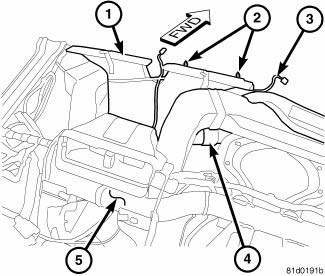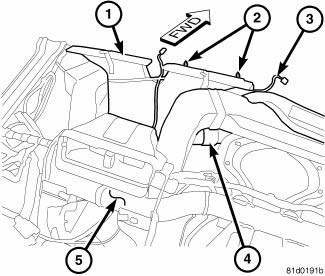Dodge Journey: Duct, defroster
REMOVAL
WARNING: Disable the airbag system before attempting any steering wheel, steering column or instrument panel component diagnosis or service. Disconnect and isolate the negative battery (ground) cable, then wait two minutes for the airbag system capacitor to discharge before performing further diagnosis or service. This is the only sure way to disable the airbag system. Failure to follow these instructions may result in accidental airbag deployment and possible serious or fatal injury.
NOTE: Take the proper precautions to protect the front face of the instrument panel from cosmetic damage while performing this procedure.
NOTE: LHD model shown. RHD model similar.

Fig. 65: Defroster Duct
1. Remove the instrument panel and place it on a workbench.
2. Remove the outboard instrument panel air outlets.
3. Remove the cover from the instrument panel.
4. Remove the driver side outboard instrument panel and demister duct assembly.
5. Disengage the two retaining clips (2) that secure the wire harness lead (3) to the top of the defroster duct (1).
6. Disconnect the defroster duct from the passenger side demister duct (4) and remove the defroster duct from the instrument panel support (5).
INSTALLATION
NOTE: Take the proper precautions to protect the front face of the instrument panel from cosmetic damage while performing this procedure.
NOTE: LHD model shown. RHD model similar.

Fig. 66: Defroster Duct
1. Position the defroster duct (1) to the top of the instrument panel support (5) and connect it to the passenger side demister duct (4).
2. Engage the two retaining clips (2) that secure the wire harness lead (3) to the top of the defroster duct.
3. Install the driver side instrument panel and demister duct assembly.
4. Install the cover onto the instrument panel support.
5. Install the outboard instrument panel air outlets.
6. Install the instrument panel.
See also:
LIGHTS
Multifunction Lever
The multifunction lever controls the operation of the
headlights, parking lights, turn signal lights, instrument
panel lights, instrument panel light dimming, interior
lights a ...
Removal
Fig. 10: Identifying Battery Cables
NOTE: If transaxle assembly is being replaced or overhauled (clutch
and/or seal
replacement), it is necessary to perform the "Quick-Learn" Proc ...
Inspection, adjustments
INSPECTION
Inspect the exhaust pipes, catalytic converters, muffler, and resonators for
cracked joints, broken welds and
corrosion damage that would result in a leaking exhaust system. Inspect the ...


